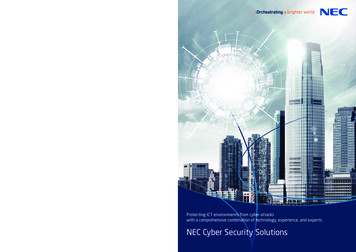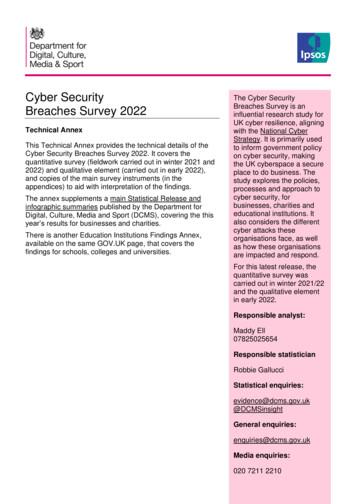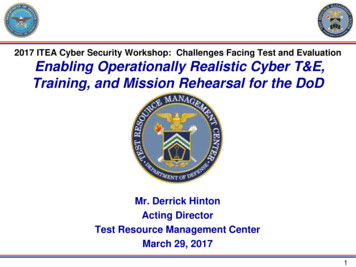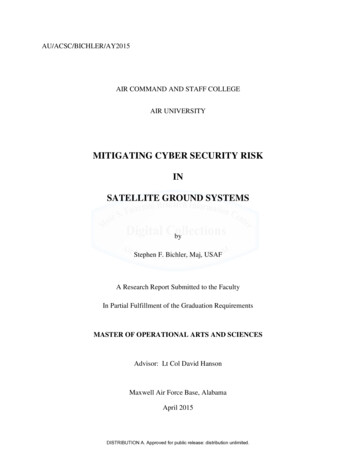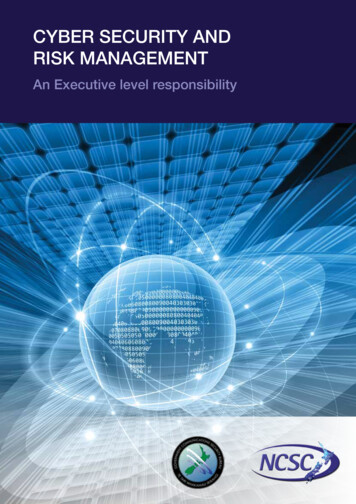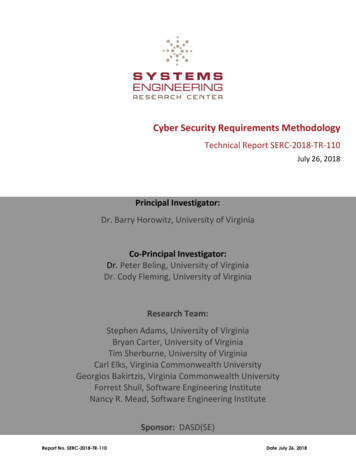
Transcription
Cyber Security Requirements MethodologyTechnical Report SERC-2018-TR-110July 26, 2018Principal Investigator:Dr. Barry Horowitz, University of VirginiaCo-Principal Investigator:Dr. Peter Beling, University of VirginiaDr. Cody Fleming, University of VirginiaResearch Team:Stephen Adams, University of VirginiaBryan Carter, University of VirginiaTim Sherburne, University of VirginiaCarl Elks, Virginia Commonwealth UniversityGeorgios Bakirtzis, Virginia Commonwealth UniversityForrest Shull, Software Engineering InstituteNancy R. Mead, Software Engineering InstituteSponsor: DASD(SE)Report No. SERC-2018-TR-110Date July 26, 2018
Copyright 2018 Stevens Institute of Technology, Systems Engineering Research CenterThe Systems Engineering Research Center (SERC) is a federally funded University Affiliated ResearchCenter managed by Stevens Institute of Technology.This material is based upon work supported, in whole or in part, by the U.S. Department of Defensethrough the Office of the Assistant Secretary of Defense for Research and Engineering (ASD(R&E)) underContract HQ0034-13-D-004 (Task Order 0538).Any views, opinions, findings and conclusions or recommendations expressed in this material are those ofthe author(s) and do not necessarily reflect the views of the United States Department of Defense norASD(R&E).No Warranty.This Stevens Institute of Technology and Systems Engineering Research Center Material is furnished onan “as-is” basis. Stevens Institute of Technology makes no warranties of any kind, either expressed orimplied, as to any matter including, but not limited to, warranty of fitness for purpose or merchantability,exclusivity, or results obtained from use of the material. Stevens Institute of Technology does not makeany warranty of any kind with respect to freedom from patent, trademark, or copyright infringement.This material has been approved for public release and unlimited distribution.Report No. SERC-2018-TR-110Date July 26, 2018ii
TABLE OF CONTENTSTable of Contents . iiiList of Figures . ivList of (Tables, Sequences) . ivExecutive Summary . 11. Introduction . 22. Cyber Security Requirements Methodology (CSRM) Description . 33. Use Case Description (Silverfish) . 53.1 Silverfish Functional System Description . 63.2 Silverfish SysML-based System Description . 84. Development and Application of Rapid Prototyping and Analytical Tools for EstablishingSystem Cybersecurity Requirements . 114.1 Rapid Prototype and Simulation Tools. 114.1.1 Silverfish Prototype Context Diagram . 114.1.1.2 Silverfish Prototype Data Model . 124.1.2 Silverfish Prototype Architecture Overview . 154.1.2.1 Hardware Architecture . 154.1.2.2 Silverfish Software Architecture . 164.1.2.3 Silverfish User Interface Overview . 174.1.3 Silverfish Cyber Attack / System Resiliency Use Cases . 204.1.3.1 Use Case Summary . 214.1.3.2 Realization of Use Case 1.1 – Manipulated Operator Commands . 234.1.4 Specific Application of Rapid Prototyping Tools . 244.2 Analysis Tools . 254.2.1 SysML and MagicDraw . 254.2.2 STAMP-based Hazard Analysis. 274.2.3 CYBOK . 275. Application of Cyber Security Requirements Methodology to Silverfish Use Case . 285.1 CSRM Step 1 . 285.2 CSRM Step 2 . 295.3 CSRM Step 3 . 325.4 CSRM Step 4 . 365.5 CSRM Step 5 . 375.6 CSRM Step 6 . 38Conclusions: Assessment of Results and Potential Future Research Efforts . 38Appendix A: List of Publications Resulted [Examples] . 41Appendix B: Cited and Related References [Examples] . 42Report No. SERC-2018-TR-110Date July 26, 2018iii
LIST OF FIGURESFigure 3.1 - SysML Block Definition Diagram for Baseline Silverfish System Architecture . 8Figure 3.2 - SysML Internal Block Diagram for Baseline Silverfish System Architecture . 9Figure 3.3 - SysML Internal Block Diagram for Baseline Silverfish System Architecture . 10Figure 4.1.1 - Silverfish Context Diagram . 11Figure 4.1.2 - Silverfish Data Model . 12Figure 4.1.3 - Silverfish Hardware Components . 15Figure 4.1.4 – Silverfish iTAR Lab Setup . 16Figure 4.1.5 - Silverfish Software Architecture . 17Figure 4.1.6 - Fire Control User Interface . 18Figure 4.1.7 - Situational Aware User Interface. 19Figure 4.1.8 - Simulation Control User Interface . 20Figure 4.1.9 - Manipulated Operator Commands - Part 1 . 23Figure 4.1.10 - Manipulated Operator Commands - Part 2 . 24Figure 4.2.1 - An example of a cross-diagram trace within the SysML model of Silverfish . 26Figure 5.1 - An internal block diagram of the baseline Silverfish architecture. . 29Figure 5.2 - Requirements diagram based on the output of the Blue Team exercise. . 32Figure 5.3 - Fire control resiliency architecture. . 35Figure 5.4 - Network resiliency architecture. . 35Figure 5.5 - Situational awareness resiliency architecture. . 36LIST OF (TABLES, SEQUENCES)Table 4.1.1.2 Silverfish Data Model . 12Table 4.1.3.1 Use Case Summary . 21Table 5.1 Results of Blue Team Consequence Prioritization Process . 30Report No. SERC-2018-TR-110Date July 26, 2018iv
EXECUTIVE SUMMARYThis report addresses the DoD/Army/SERC-sponsored, UVA-led 9 month research effort todevelop a methodology for establishing cyber security requirements at the preliminary designphase of new physical systems programs. The requirements addressed include the integration ofcyber attack defense and resilience solutions, as well as security-related software engineeringsolutions. Referred to as Cyber Security Requirements Methodology (CSRM), the developedprocess includes six sequential steps conducted by three teams (an operationally focused team,a cybersecurity focused team and a systems engineering team). Model-based engineering toolswere utilized to support each of the steps. A trial weapon system use case was conducted to gainan initial evaluation of the methodology. The use case system, referred to as Silverfish, washypothetical, but deemed as a reasonable representation of a possible weapon system. Resultsof the trial were promising and point to a number of possible paths for follow-on researchincluding implementing the methodology on a real system and building the necessary tools toscale up the methodology to a real system.Report No. SERC-2018-TR-110Date July 26, 20181
1. INTRODUCTIONHistorically, both the cyber security and system engineering (SE) communities have pointed tothe desirability for addressing cyber security requirements early in the overall design process fornew systems. Prior University of Virginia (UVA) research efforts, referred to as System AwareCyber Security, have addressed cyber attack resilience requirements as a subject associated withthe design of cyber physical systems. Correspondingly, one would expect to address cyber attackresiliency early on in an organization’s processes for system design. As related to the topic of thispaper, the UVA research team has recognized that cyber attack resilience requirements need tobe considered in the context of other aspects of cyber security (e.g., cyber security defenserequirements, software quality management as related to cyber security) because the differentmechanisms for addressing system cyber security can serve to efficiently complement each otherin achieving an overall desired level of protection. The recognition of the desirability to considerthe multiple aspects of cyber security concurrently in order to properly address resiliencyrequirements served to motivate the UVA research team to develop an integrated cyber securityrequirements methodology. A multi-organization research team was formed for defining themethodology, consisting of UVA (team lead), the Software Engineering Institute (SEI), the VirginiaCommonwealth University (VCU) and the US Army’s Armament Research Development andEngineering Center (ARDEC). Each of these organizations brought a particular focus required bythe research activity; UVA/SE, SEI/cyber attack threat analysis, VCU/cyber attack analysis tooldevelopment, ARDEC/ weapon system design. The team defined a 9-month project to develop acyber security requirements methodology (referred to as CSRM) that could be embedded withinthe preliminary design timelines used for DoD development projects and a first trial applicationto serve as a basis for evaluation and refinements to the methodology. Section 2 outlines theresulting methodology. Section 3 describes the hypothetical weapon system used as the initialtrial use case. Section 4 highlights a set of analysis and prototyping/simulation tools developedto support the CSRM. Section 5 presents results from the trials. Section 6 provides an assessmentof results derived from the project and areas where future research can contribute to advancingthe opportunity for addressing cyber security requirements for cyber physical systems.In order to suitably address the cyber attack resilience aspect of cyber security, the UVA SE teamdeveloped the following definition related to cyber physical systems as a derivative of a broaderresilience definition presented by the Idaho National Laboratory in 2009:Cyber Attack Resilience - the capacity of a system to maintain state awareness (implies amonitoring process of physical and software-related states) as a means for detecting cyberattacks, and to proactively maintain a safe level of operational normalcy through rapid systemreconfigurations in response to detected cyber attacks that would impact systemperformance. Maintaining operational normalcy includes containing the immediateconsequences of the detected attack and post-attack forensic support based upon the datacollected for detecting attacks.Report No. SERC-2018-TR-110Date July 26, 20182
As part of UVA’s System Aware Cyber Security concept, the required anticipatory processes formonitoring and reconfiguration is conducted by a subsystem referred to as a Sentinel, whichshould be far more secure than the system being addressed for resiliency. While the cyber attackdetection process is expected to be automated, the level of reconfiguration automation may varyacross system functions: Totally Automated (Sentinel determines what to do and informs appropriately trainedsystem operators regarding automated execution) Semi-automated (System operators receive automated recommendation(s) fromSentinel and, accounting for both battle context and a broader set of informationavailable to them, decide on what to do) Manual (Operators, or higher levels in the command hierarchy, determine what to do)2. CYBER SECURITY REQUIREMENTS METHODOLOGY (CSRM) DESCRIPTIONThis section presents the six-step cyber security requirements (CSRM) methodology that wouldbe carried out by three collaborating teams, derived as a result of the research efforts discussedin this paper. In addition, it introduces how analysis and rapid prototyping/simulation tools canbe used to support decision-making regarding cyber security requirements. Section 4 discussesthe use of the SysML and analysis tools in detail.The CSRM for cyber physical systems introduced in this research activity is risk-based. Risk isdetermined by the consequences that would occur should a particular cyber attack scenariooccur and the likelihood of that scenario actually occurring. Consequences can range, forexample, from human injury or loss of life, to loss of control, to corruption or delays of situationawareness information, to denial of a system operation. The CSRM recognizes that the owners,operators and users of a system are the appropriate community of people to consider andprioritize the potential consequences that need to be avoided. The CSRM also recognizes thatthe cyber attackers (adversaries) are the community of people that prioritize and ultimatelydetermine the likelihood of specific cyber attacks occurring. Cyber security solutions are intendedto influence the likelihood of attacks and, in particular, cyber attack resiliency solutions areintended to address the consequences of detected attacks. The six-step CSRM is divided in amanner that addresses this division of risk and the three teams that execute the CSRM providethe knowledge required to address the six steps.The objective of CSRM is to augment current preliminary design efforts for new cyber physicalsystems with a timely and efficient process that addresses the cyber security requirements forthe system. As discussed in Section 1, the individual elements for achieving cyber security (e.g.,cyber attack defense, cyber attack resilience) are complementary, and would best be done in acollective effort when the new system is being designed. During this phase of system design,important initial decisions can be made regarding system architecture, including for example: Separation and isolation of hardware and software supporting different systemfunctions,Report No. SERC-2018-TR-110Date July 26, 20183
Use and selection of off-the-shelf products, accounting for historical cyberattacks,Dependence on defense capabilities, with specific solutions to be selected whendesign is sufficiently mature,Where within the new system’s development process to focus the mostemphasis and corresponding resources regarding SW development processes(quality assurance tools, testing, developer skills, life cycle support, etc.),Design and performance requirements for resilience-related capabilities both forimmediate implementation and to facilitate simpler addition in preparation forhigher likelihood requirements over the life-cycle,Addressing the operator related aspects of resiliency through rapid prototypingexperiments and exercise-related support tools.The six-step CSRM emerged from this research effort as an efficient and potentially high-valuemechanism to conduct a risk assessment that would lead to the desired architectural designdecisions. The individual steps are listed below: Step 1 – High level, tool-based, system description produced by SE, including systemarchitecture and functional description – MagicDraw’s SysML implementation was thechosen system description support tool that was used across all 6 stepsStep 2 – Blue Team consequence analysis, resulting in a prioritized list of systemfunctional problems to be avoidedStep 3 – SE team derivation of resilience solutions (described via use of SysML) thatrespond to Blue Team resultsStep 4 – Red Team, based upon experience with cyber attack threats, COTS and GOTScyber defense solutions and defense and use of a VCU analytical tools for confirmationof attack-related assumptions (discussed in Section 4), prioritizes software engineeringsolutions, cyber defense solutions and resilience solutionsStep 5 – SE team adjusts SysML system description to account for Red Teamrecommendations and rapid prototyping/simulation results for presentation to BlueTeam; Initiates cost analysis effortStep 6 – Blue Team responds to Red Team recommendations and simulation results withtheir revised consequence prioritization of solutions, thereby enabling SE team toprovide an integrated system design discussion for requirements-related decisionmakers that would include considerations of cost, as well as risk reduction.The CSRM requires three teams to carry out the steps; a systems engineering team (SE Team), aBlue Team and a Red Team. The roles of each of the three teams are presented below.The SE Team (UVA for the trial use case) would consist of a group of people with a broad rangeof skills, including technical and operationally related experience. They would be required to havestrong analytical skills and the ability to use system description and assessment tools. The teamwould be required to develop (or provide from the overall cyber physical system project’s SEteam) an initial high level System Design, without cyber attack-related resilience features, to startReport No. SERC-2018-TR-110Date July 26, 20184
to work with. Based upon the Blue Team’s prioritized consequence avoidance assessment, theSE Team would derive potential resilience features and the architecture for their implementation(e.g., 3 or 4 possible resilience system augmentations for consideration). After receiving the RedTeam’s prioritized solution assessments, the SE Team would derive integrated solutionalternatives that account for the full risk analysis (sensitive to both Blue and Red Team analyses).The SE Team would also be responsible for the coherent management of the methodologyprocess, updating the system descriptions to account for the new solutions as they emerge fromthe CSRM process.The Blue Team (ARDEC for the trial use case) would be an operationally-oriented group, includingmembers experienced in addressing use of systems under duress (not necessarily cyber attacks,but perhaps electronic warfare attacks or weapon-fire attacks). It would be desirable for the BlueTeam to have knowledge regarding operational practices, and their purposes, for legacy systemsthat were related to the system to be developed. The team would focus on the Consequencecomponent of risk, providing a prioritized view for the various system functions of consequencesto be avoided (e.g., denial of service, corruption of information to operators, delays in execution,etc.). As required, the Blue Team would be supported by the SE Team regarding interpretation ofthe tool-based representation of the system under consideration. An important CSRM attributeis that Consequence analysis need not include inputs from cyber security experts.The Red Team (SEI, VCU for the trial use case) would be focused on the identification oflikelihoods of potential cyber attacks, both with and without the application of potential solutionsto the overall system design. The team would provide a view on the relative efficacy of differentcyber security solutions, prioritizing the relative importance of SW quality solutions, defensesolutions and resiliency solutions, including considerations of past cyber attacks and SWvulnerabilities to attack. The members of the team would be expected to pose alternativesolutions and assessments of the corresponding impact of potential solutions regarding relatedcyber attack likelihoods. An important attribute of the CSRM is that the Red Team consists of amixture of cyber attack expertise and cyber security expertise, working together to iterativelydevelop an assessment that relates solution selection with likelihoods for influencing attacklikelihoods.The following section of the paper describes the trial use case for the initial evaluation of theCSRM.3. USE CASE DESCRIPTION (SILVERFISH)As part of preparing for an initial trial of the CSRM, an initial weapon system (to be referred to asSilverfish) use case was developed to serve as an initial application. Silverfish is a hypotheticalsystem, but was deemed by the ARDEC team as sufficient for the purposes of CSRM development.In addition to supporting the development of the CSRM, the Silverfish use case is also intendedReport No. SERC-2018-TR-110Date July 26, 20185
to support research related to both decision support tool development and rapidprototyping/simulation efforts to help identify potential system resilience solutions. Section 3.1provides a functional description of Silverfish and Section 3.2 provides a corresponding SysMLbased description.3.1 SILVERFISH FUNCTIONAL SYSTEM DESCRIPTIONThe Silverfish system is a rapidly deployable set of fifty (50) individual ground-based weaponplatforms (referred to as obstacles) controlled by a single operator. The purpose of the system isto deter and prevent adversaries from trespassing into a designated geographic area that islocated near a strategically sensitive location. The system includes a variety of sensors to locateand classify potential trespassers as either personnel or vehicles. An internal wirelesscommunication system is used to support communication between the sensors and the operator,and also supports fire control communications between the operator and the obstacles. Thesensors include obstacle-based seismic and acoustic sensors, infrared sensors and an unmannedaerial vehicle-based surveillance system to provide warning of potential adversaries approachingthe protected area. The operator is located in a vehicle, and operates within visual range of theprotected area. The operator is in communication with a higher-level command and control (C2)system for exchange of doctrinal-related and situation awareness information. A more detailedfunctional description of the system is presented below. Section 3.2 provides the correspondingSysML representation for Silverfish. Purpose: Deter and prevent, when and where necessary, via the use of rapidlydeployable obstacles, adversarial tracked vehicles (assumed maximum speed - 10mph)or individuals from trespassing into geographic areas that are close to strategicallysensitive locations.Prohibited Area: 100 acres of open field space (100 acres, approximately 0.16 squaremiles 0.4 mile x 0.4 mile area). At maximum speed a vehicle would take about 3minutes to cross the prohibited area.Obstacle Deployment: About 50 obstacles are available to be distributed over the 100acre protected area (each obstacle is designed to protect a 300x300 foot area). Twotypes of obstacles can be deployed. One type of obstacle addresses anti-personnelrequirements. It contains six (6) short-range sub-munitions, each covering a 60-degreeportion of a circular area to be protected. The second type of obstacle contains a singlemunition capable of impacting a tracked vehicle.Operation: The operator, located in a vehicle that is operated close to the prohibitedarea ( 150 meters away), remotely controls individual obstacles and their submunitions, based upon sensor-based and operator visual surveillance of the prohibitedarea.Prohibited Area Surveillance: The operator is supported by obstacle-based acoustic andseismic sensors (geophones and accelerometers) that can detect and distinguishbetween vehicles and people, redundant infrared sensors that can detect and track themovement of people and vehicles, and real-time Video/IR derived early warninginformation regarding people and vehicles approaching the prohibited area provided byReport No. SERC-2018-TR-110Date July 26, 20186
a UAV managed by the operator. The UAV is used to provide warning information. Theoperator can relocate his or her vehicle for improved visual observation.Obstacle design features: The obstacle-based sensors provide regular operator situationawareness reports (seconds apart) when they detect a trespasser. They provide, at alower data rate (e.g., a minute apart), general health related information, includingreports on their location (GPS-based), their on-off status, and their remaining batterylife. Should a weapon be fired, the obstacle confirms the acceptance of commands andthe actual firing events. To address potential tampering risks, obstacle-based softwarecan only be modified by electrically disconnecting their platform-based computer fromthe obstacle, and removal results in self-destruction of that computer.Infrared sensor configuration: A single pole-mounted IR sensor is assumed to be capableof providing surveillance of the entire protected area. A second sensor is provided forredundancy, and can be used to provide surveillance of areas that the single sensor isnot able to observe. The IR sensors provide the same type of operator situationawareness data at the same rates as the obstacle-based sensors, but in addition providetracking information to enable the operator to project future locations of movingvehicles or people.Requirements for Avoiding Errors: Concerns exist regarding detonating sub-munitions incases where non-adversarial vehicles or people, by chance, enter the prohibited area.Concerns also exist about failing to fire munitions when an adversary is approaching astrategically sensitive location via the prohibited area. The operator, when possible, canuse visual observations to increase confidence regarding fire control.Operator Functions: The operator can set the obstacles into either on or off modes andcan cause individual or designated groups of obstacles/sub-munitions to detonate whenin on mode. Obstacles can be commanded to self-destroy designated criticalinformation in order to prevent adversaries from collecting such information for theirown purposes. The operator also can launch a quad-copter drone (UAV) to providevideo/IR based early warning information regarding potential trespassers of theprotected area ( 5 minute warning for vehicles approaching at a 10 mph speed).Communications Systems: The Operator, the higher level C2 System, and UAV operateon a shared radio system that is integrated to a relay node(s) that couples into theSilverfish system’s integrated wireless communication network. The communicationsystem includes digital interfaces that support formatted data transfers between theoperator’s system, the UAV subsystem, the individual obstacles, the IR subsystem, andthe C2 Center. The communication system also supports short message text and voicecommunications between operator and C2 system.Operator Control Station: The operator is provided with a vehicle-mounted computer(s)subsystem that provides situation awareness information including individual obstaclestatus, and sensor-based situation awareness information. The subsystem also providescomputer-based entry and corresponding weapon system feedback for fire controlrelated inputs from the operator. The control station also supports required digitalsituation awareness-related reporting to the C2 center, as well as support for UAVcontrol.Report No. SERC-2018-TR-110Date July 26, 20187
Cyber Security Requirements Methodology Technical Report SERC-2018-TR-110 July 26, 2018 . an initial evaluation of the methodology. The use case system, referred to as Silverfish, was . SEI/cyber attack threat analysis, VCU/cyber attack analysis tool development, ARDEC/ weapon system design. The team defined a 9-month project to develop a .



